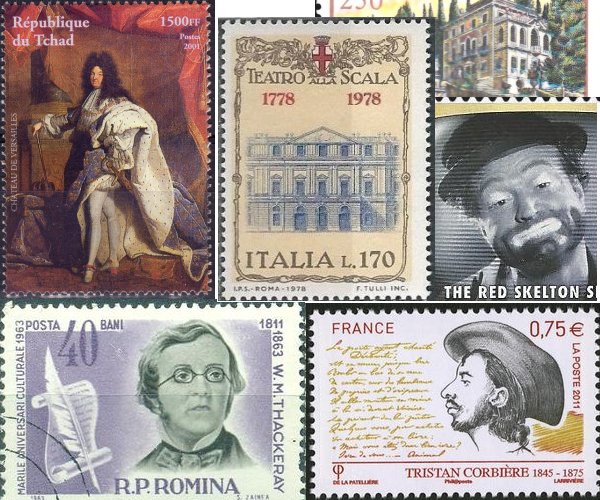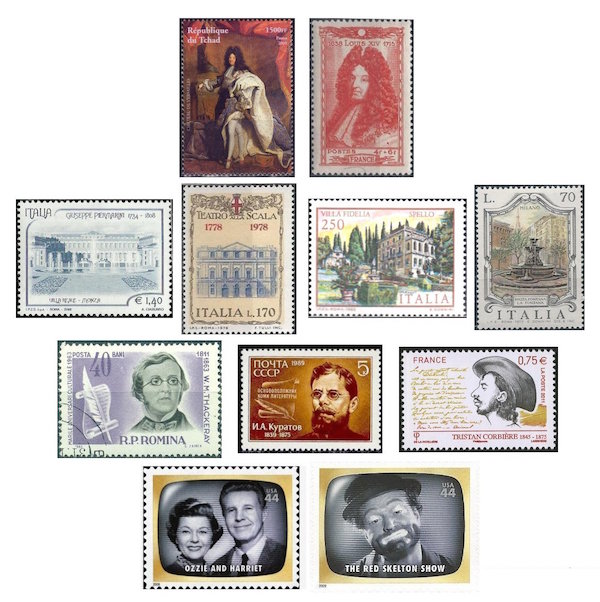The Arts on Stamps of the World — July 18
An Arts Fuse regular feature: the arts on stamps of the world.

By Doug Briscoe
French painter Hyacinthe Rigaud (18 July 1659 – 29 December 1743) is best known for his famous portrait of Louis XIV (1701), as reproduced on a stamp from Chad. The French one draws upon the same portrait. Rigaud, born in Perpignan with the Catalan name Jyacintho Rigau or Jacint Rigau i Ros, must be one of the only winners of the prix de Rome who never went to Rome. Rigaud painted not only members of the royal family, but virtually all of the important personages of the court, as well as prominent artists such as La Fontaine and the painter Pierre Mignard.
Besides one stamp from 2008 issued specifically in his honor, Italian architect Giuseppe Piermarini (18 July 1734 – 18 February 1808) is further represented by his work on at least three more stamps of Italy. The most celebrated of these projects is undoubtedly the opera house of La Scala in Milan (1776–78). The building shown on the Piermarini stamp, though, is the Royal Villa at Monza (1777-80), which he built for the Archduke Ferdinand of Austria, as Lombardy was then part of the Austrian Empire. Among his other structures are the Villa Fidelia at Spello near Assisi and, back in Milan, where most of his work can be found, the fountain in the eponymous Piazza Fontana. Piermarini was born at Foligno in the Papal States and worked under Luigi Vanvitelli in Caserta and Rome. Here is a portrait of him by Martin Knoller.
Given the propensity of the Royal Mail to ignore Britain’s great creators on stamps, it should come as no surprise that the UK has never issued a stamp for William Makepeace Thackeray (18 July 1811 – 24 December 1863). What may surprise you, though, is that Romania has! In fact, the only Thackeray stamp I could find was issued by that country in 1963, the centennial of the writer’s death. I mentioned here on Hawthorne’s birthday that when I was nineteen I bought a lovely 22-volume set of that writer’s works in an antiquarian book store in Los Angeles. On that same occasion, I also purchased a 30-volume set of Thackeray from 1907, and I must confess that almost all of my Thackeray-reading was done in the immediately succeeding years. Vanity Fair I had already read with much pleasure for a college course, but now I devoured Pendennis, The Newcomes, Barry Lyndon, and some of the less well known matter such as Denis Duval, Yellowplush Papers, and Fitzboodle’s Professions. But other than rereading “The Four Georges”, from which I derived no more than when I had read it the first time, my Thackeray collection has been collecting only dust.

But that’s more than I can say for the poet Ivan Alekseevich Kuratov (18 July [O.S. 6 July] 1839 – 29 November [O.S. 17 November] 1875), of whose work I’ve never read a word. (But then, neither have you.) He is important as the founder, or at least revivifier, of Komi literature. The Komi Republic is a huge area within Russia, and yet still west of the Urals, whose capital, Syvtykvar, is some six or seven hundred miles northwest of Moscow. The Komi language is part of the Finno-Ugric (Finnish-Hungarian) group, and the first book to be printed in the language appeared only in 1815. Kuratov attended a seminary, where he began writing poetry at 13. He worked as a teacher and translated Russian literature (Pushkin, Krylov, et al.) into Komi. Only five of his poems were published during his lifetime.
French poet Tristan Corbière (18 July 1845 – 1 March 1875) is another of those tragic cases of a talent stilled by tuberculosis. He was 29 when he died. Born Édouard-Joachim Corbière in Breton, his father was a writer who had had a best-selling novel. While at school, freezing, Corbière developed rheumatism; the experience as a whole colored his creative work with its tendency to disdainful sarcasm. As in the case of Kuratov, Corbière’s published work amounted to little, but it was enough to catch the eye of Paul Verlaine, who rescued the poet’s name from obscurity.
Two American TV stars share this July 18 birthday: Harriet Nelson and Red Skelton. Both, as it happens, show up on the same big sheet of twenty stamps called Early TV Memories issued in 2009. Harriet Nelson (July 18, 1909 – October 2, 1994) was born Peggy Lou Snyder in Des Moines and, having started in vaudeville, was performing on Broadway while still in her teens. She met future husband Ozzie Nelson in 1928 and sang with his band under the name Harriet Hilliard. Among her numerous screen roles was one in Follow the Fleet (1936) with Fred Astaire and Ginger Rogers. The Adventures of Ozzie and Harriet began on radio in 1944 and aired on television from 1952 to 1966. Richard Bernard “Red” Skelton (July 18, 1913 – September 17, 1997) also worked in vaudeville and on radio before migrating to TV, and he, too, was in a movie with Ginger Rogers, Having Wonderful Time (1938), his first film. His TV programs ran from 1951 to 1971. He suffered the heartbreak of losing his nine-year-old son to leukemia; ironically, Skelton himself very nearly died of an asthma attack just a few months before his son’s death. Skelton was also a prolific painter (mostly of clowns) and writer of short stories and songs.
A graduate of the University of Massachusetts with a B.A. in English, Doug Briscoe worked in Boston classical music radio, at WCRB, WGBH, and WBUR, for about 25 years, beginning in 1977. He has the curious distinction of having succeeded Robert J. Lurtsema twice, first as host of WGBH’s weekday morning classical music program in 1993, then as host of the weekend program when Robert J.’s health failed in 2000. Doug also wrote liner notes for several of the late Gunther Schuller’s GM Recordings releases as well as program notes for the Boston Classical Orchestra. For the past few years he’s been posting a Facebook “blog” of classical music on stamps of the world, which has now been expanded to encompass all the arts for The Arts Fuse.
